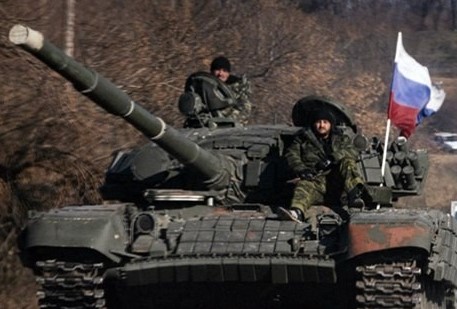Russia inadvertently reveals how it poured ammunition into Ukraine in 2015

Independent journalists have used a Russian railway tracking service to confirm how Moscow sent thousands of tons of ‘explosive substances’ to occupied Donbas in early 2015 and to identify the Russian military sites from which they were sent. Although the smoking gun stops on the Russian side of the border with occupied Donbas, it ends at a place inhabited by around one thousand people, and no evidence that any of these vast loads were returned to sender.
Denis Kazansky, a Ukrainian journalist originally from Donetsk, explains that, “for obvious reasons”, he cannot reveal the identity of the other people who took part in this investigation, however he can divulge the almost comically simple method that they used. Since 2019, there has been a tracking service called Gdevagon.ru, which, for a fee of three thousand roubles, will provide information about Russian railway traffic via particular stations.
They accordingly ordered information about the movement of freight through the station Uspenskaya which is on the border of the Rostov oblast in Russia and the areas of Donbas under militant control. It should be recalled that this part of the border has not been under Ukrainian government control since early in the war. Uspenskaya is literally the last station before Ukraine on a road leading towards Ilovaisk in the Donetsk oblast. Kazansky and his colleagues asked specifically for the freight traffic in January 2015, a period of fierce battles for the Donetsk Airport and for the crucial city of Debaltseve. They discovered, and Kazansky demonstrates in his video, that during this period thousands of tons of explosive materials went through Uspenskaya.
Russia has already claimed to the UN’s International Court of Justice that the tanks and ammunition used by the Russian / pro-Russian militants “were found” in old Soviet mines in Donbas, and it would doubtless assert here that Uspenskaya was the final destination for all this material. There is, however, no ammunitions factory or other storage facility at Uspenskaya, and the material in question came from different places in Russia with military units and stockpiles of ammunition.
For those following the fighting in Donbas, the above is anything but breaking news. While Russia has continued to deny its direct involvement in the conflict, the Joint Investigative Team and Dutch prosecutor, in investigating the downing by a Russian BUK missile over Ukraine of Malaysian airliner MH17, have presented considerable evidence of the military source for the BUK missile launcher involved. These investigations have also revealed witness testimony and intercepted telephone calls which demonstrate direct contact between militant leaders and Russian government and military officials, as well as the Russian FSB [security service]. In one conversation from 3 July 2014, Alexander Borodai, the Russian ‘prime minister’ of the self-proclaimed ‘Donetsk people’s republic’ [‘DPR’] can be heard stating that he is “carrying out orders and protecting the interests of one and only state, the Russian Federation’.
During the first months of the fighting, Moscow assiduously pushed the line that all the Russians in Donbas were there as ‘volunteers’. That is still the official line, however in the middle of August 2014, as Ukraine’s Armed Forces were set to drive out the militants, Russia began quite openly sending vast amounts of military hardware and men into Donbas.
During the battle first for Ilovaisk and then, in early 2015, for Debaltseve, Russia is known to have used military personnel. The Conflict Intelligence Team of investigative journalists have produced evidence suggesting that it was Russian President Vladimir Putin who ordered the offensive at Debaltseve. The latter is a strategic railway hub which was under Ukrainian government control on 12 February 2015 when Putin agreed a ceasefire with the leaders of Ukraine, France and Germany in Minsk, one which the Russian-controlled militants immediately announced would “not apply” to Debaltseve. It was also Putin who gave a state award to Alexander Minakov for “services to the Fatherland’ almost certainly for his role at Debaltseve.
In a study entitled Russian Forces in Ukraine and published in March 2015 by the UK-based RUSI [the Royal United Services Institute for Defence and Security Studies], military specialist Igor Sutyagin estimated that there were at least 10,500 – 11,000 Russian troops operating in eastern Ukraine by March 2015.
Sutyagin wrote that “Direct intervention by Russian troops in combat roles then followed in the middle of August, when the prospect of rebel defeat had become realistic. The presence of large numbers of Russian troops on Ukrainian sovereign territory has, more or less, since become a permanent feature of the conflict.”
This coincides with the first reports of Russian military casualties in Russian independent media (see: If Russia is not at war, then who is in those freshly-dug graves? and Entire Pskov paratrooper regiment killed in Ukraine? ).
Russia has since classified any information about military losses in peacetime as a state secret; has banned any soldiers from using social media; and has used a variety of other measures, from bribery to threats, to prevent the families of soldiers killed, from talking about this (details here).
The Russian militants who played critical roles in the conflict in Donbas in 2014, including Borodai, have themselves acknowledged that they would have been defeated without Russia’s substantial ‘help’ (see also Key insurgent admits there was no civil war, just Russian aggression .)
It is also likely that Russia’s so-called ‘humanitarian convoys’, which illegally cross the uncontrolled border into occupied Donbas are involved in transporting death and suffering. There would also be no reason for Russian convoys to be travelling by night on dirt roads near the uncontrolled border, but at places where there are no border crossings, if they did not have weapons of destruction that they wanted to hide (details here).





